The beautiful smell of incentive sticks, artistic crafts in the walls, soothing music, hymning of chants, takes you to the ancient Mani Rimdu Festival. Mani Rimdu is a 19-day festival celebrated by Buddhists in the Everest Region of Nepal.
The birthplace of the enlightened, “Light of Asia”, Lord Buddha, sits in the heart of Nepal. Also, this pure Himalayan land in ancient times has some hidden caves where the Buddhists isolated themselves in meditation. The Buddhist celebration was also originated from a similar place. The monasteries in the Everest District celebrates the pride festival. However, the main host of the Mani Rimdu is the Tengboche Monastery in the backdrop of Mount Ama Dablam.
The prayer wheels sing the music of gratefulness to have a life that celebrates. The prayer flags along these regions remind you of the freedom to colorful destinations that your life carried you through. When you understand you are what you have been looking for, that’s the influence of Mani Rimdu, certainly. Like the oil lamp, you radiate light, that will be your travel picturesque view story.
Table of Contents
History of Mani Rimdu Festival
Beginning with the Rongbuk monastery, this festival signifies mythological events and the victory of positive forces against destroying evil demons. The first monastery in Nepal to observe the Mani Rimdu festival was Tengboche in 1938. While people believe it to have later moved to Solukhumbu and started between 1907 and 1910 (As per Trulshik Rinpoche’s estimation).
When is the festival observed?
Mani Rimdu is attended for nineteen days, as per the Tibetan lunar calendar in the Everest region. Buddhists in the Himalayas cordially embrace the mark of the foundation of Buddhism by Guru Rinpoche Padmasambhava. As per this Tibetan lunar calendar, this ancient festival takes place from the first day of the tenth month. That means as per the English calendar, they observe it in between October and November following the autumn full moon. In the Nepali calendar, it falls straight away after Kojagrat Purnima, the fifteenth or last day of Dashain or the full moon day.
Just as per tradition, the date for the celebration of Mani Rimdu has been specified as 20th, 21st, and 22nd of October.
Why should you visit Mani Rimdu?
“Mani Rimdu” attributes, ‘Mani’ meaning the “part of the chant of Chenrezig” and ‘Rilbu’ whereas ‘Rimdu’ explains as the small red pills that are blessed during the festival. Buddhists honor the Mani Rimdu festival around the Khumbu region.
Awe-inspiring shows celebrate three occasions at the monasteries of Chiwong, Thame, Tengboche in the Solukhumbu district of Nepal. Buddhist monks come up with sacred ritualistic masked dances wearing costumes as well as perform Tantric rituals at these monasteries. These dances are primarily to give color on marking the triumph of Buddhism to Bon. The Lamas and Sherpas of the monastic community pray for a sacred series for empowerment. Likewise, the locals and tourists gather crowds to celebrate. One claims it to be the best trek reward to keep up with the ideal culture and great Himalayan Sherpas picturesque views.
Every year a lot of travelers wait to coincide with this festival along with their organized trek on Heaven Himalaya. And, trips like Everest Base Camp Trek, Everest Gokyo Lake Trek, etc. take you to the monasteries where the people celebrate the festival.
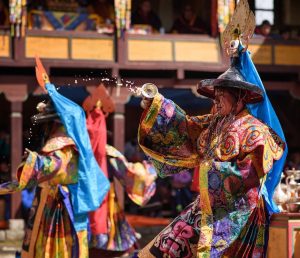
Buddhists performing puja in Mani Rimdu. Credit: @fotografie_achenbach | Instagram
Mani Rimdu Preparations
Mani Rimdu is celebrated for days in a series. They make different preparations and celebrations on different days.
Formation of Sand Mandala
Buddhists built sand Mandala in a very sophisticated and symbolic process with colored sand step by step. The major highlight of this creation is the main idol of Mani Rimdu, Buddha of kindness. The defensive blades around the Mandala and a bowl of Mani Rilwu pills (spiritual medicine) placed above the center symbolize various deities they believe in.
There’s a belief that during meditation, kindness flows effortlessly in ‘mantra form’ along with the Mandala and in Mani Rilwu pills. Therefore, most people attend the festival in the hope to receive kindness.
It is not a day’s work, rather it requires a great deal of concentration and days to complete. The Palace of Garwang Thoze Chenpo (Lord of the Dance) is epitomized by the magnificent mandala. Before the public ceremony, the monk chants “OM AH HUNG RHI, OM MANI PADME HUMG” thousands of times during the weeks of the ceremony.
Wong (The Empowerment)
On the full moon day of the tenth month in the Tibetan lunar calendar, they open the ceremony to the public. Then they distribute Rilwu (sacred or blessed pills), as well as Tshereel pills to the attendees with a blessing for long life. They say the Rilwu or the Tshereel empower people. So, the visitors take Prasad with utmost honesty.
Chham (The Dances)
The 2nd day of Mani Rimdu is full of dance rituals. The sacred dances personalize the transformation of Protectors of Dharma, where the symbolic demons are conquered and chased away.
They make the positive forces to fight with those in favor of disorder through the dances thematically. The dances convey Buddhist teaching on many levels, from the simplest to the most philosophical.
Ser-Kyem
In the Tibetan language, “Ser” means gold, and “Kyem” means “drink”. Ser-Kyem comprises a larger raised dish-shaped bowl and a smaller dish in an upright position (offering bowl). It is used to make tea offerings to Dharma guards like Mahakala. Also, they offer spiritual nectars in many other functions.
The Tantric magicians and Ngag-pa represent six dancers performing in the ceremony. Tibetan Buddhist practice is crucial to becoming enlightened and virtuous. For this reason, they offer alcohol from silver vessels and small tormas to the Khandro, Lama, Yidam, and Shi-Dak (the Earth deities).
The Fire Puja (Jinsak)
The Fire Puja symbolizes the offering to the god of fire, Agni, and to the mandala gods to pacify the possible worldly harms in the world. The grain and the ghee are burnt so that the harm can be envisioned. As soon as the sand mandala is distorted, they offer the sand to the serpent gods (Nags).
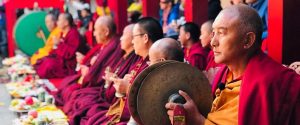
Monks doing fire puja in Mani Rimdu festival
Chhingpa
Four Protecting Ghings, defending the Buddhist faith against demon attack is the presenting essence of the next dance. Shining paper masks hide the faces of the dancers, each a different color and each displaying a constant smile. The dancers rhythmically dance along with the beating of cymbals that are hidden by shining paper masks. Sometimes, they scare the audience and children too.
Heaven Himalaya organizes many treks to coincide with the festival time in the Everest region of Nepal. There are many unique festivals in Nepal celebrated somewhere in the country, and Mani Rimdu is one of a kind.
The value of life lies in sitting under the open roof with a slight breeze experiencing the inherited heritage in the grandeur of the Himalayas. Wake up in the peaceful celebration of the Mani Rimdu festival above the clouds.

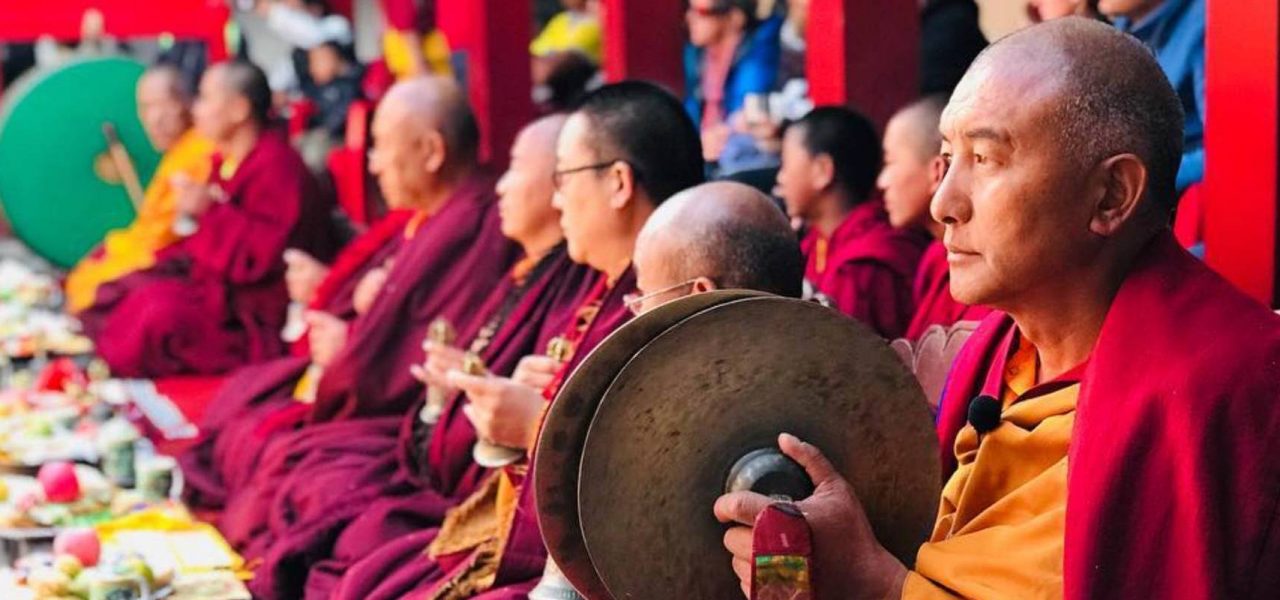

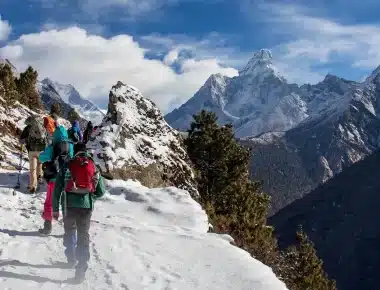
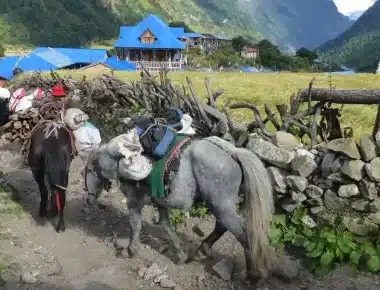
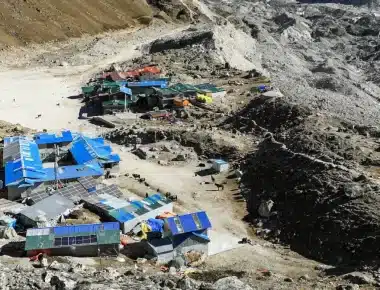
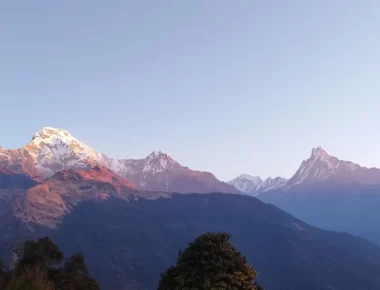

[…] through Tengboche monastery where Mani Rimdu festival is observed, and monks perform daily […]